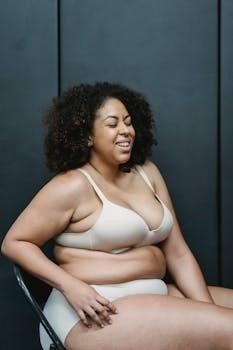Women’s Underwear Size Guide
Finding the right underwear size is essential for comfort and confidence. This guide provides comprehensive charts and tips to help you determine your perfect fit. Explore various brands and styles with ease.
Finding the perfect fit in women’s underwear can sometimes feel like a daunting task, but it’s a crucial step towards ensuring comfort and confidence throughout your day. Ill-fitting underwear can lead to discomfort, irritation, and even affect the way your clothes look and feel. This comprehensive guide aims to simplify the process, providing you with the necessary tools and knowledge to navigate the world of underwear sizing with ease.
From understanding your measurements to deciphering size charts and choosing the right style for your body type, we’ll cover all the essential aspects. Whether you’re shopping for everyday panties, supportive shapewear, or comfortable bralettes, this guide will empower you to make informed decisions and discover the perfect underwear that fits and flatters your figure. Say goodbye to uncomfortable underwear and hello to a confident and comfortable you!
Understanding Your Measurements
Before diving into size charts, it’s essential to accurately measure your body. This ensures you select underwear that fits comfortably and provides the support you need. The two key measurements for underwear are your waist and hip measurements.
For your waist measurement, locate the natural waistline, which is usually the narrowest part of your torso; Wrap a measuring tape around your waist, ensuring it’s snug but not too tight. The tape should be parallel to the floor.
Next, measure your hips at the fullest point. Stand with your feet together and wrap the measuring tape around your hips, again ensuring it’s parallel to the floor. Note both measurements in inches or centimeters, as this will be your reference point when consulting size charts. Accurate measurements are the foundation for finding the perfect fit.

Waist Measurement
The waist measurement is a crucial step in determining the correct underwear size. To obtain an accurate waist measurement, it’s important to follow a few simple steps. First, stand upright with your feet shoulder-width apart. Locate your natural waistline, which is typically the narrowest part of your torso, usually just above your belly button.
Wrap a flexible measuring tape around your waist at this point, ensuring that the tape is parallel to the floor. The tape should be snug against your skin but not so tight that it digs in or restricts your breathing. Take the measurement while exhaling normally.
Record the measurement in inches or centimeters, depending on the size chart you’ll be using. This measurement will be a key factor in selecting underwear that fits comfortably around your waist without being too tight or too loose.

Hip Measurement
Accurately measuring your hips is vital for selecting the right size of underwear, ensuring comfort and a flattering fit. To take your hip measurement, stand with your feet together. Find the widest part of your hips, usually a few inches below your waistline.
Wrap a flexible measuring tape around your hips at this point, keeping the tape parallel to the floor. Make sure the tape is snug but not too tight, allowing it to sit comfortably against your body. It shouldn’t dig into your skin.
Take the measurement while standing naturally, ensuring you’re not flexing or altering your posture. Record the measurement in inches or centimeters, depending on the size chart you’ll be using. This measurement is crucial for determining the appropriate size for panties and other types of underwear that sit around your hips. Refer to size charts to find the best match.
Different Types of Underwear and Sizing
Navigating the world of women’s underwear involves understanding that sizing can vary significantly depending on the style and brand. Different types of underwear, such as panties, shapewear, and bralettes, each have their own specific sizing considerations. Panties, for example, rely heavily on hip measurements, while shapewear often considers both waist and hip measurements to ensure a snug yet comfortable fit.
Bralettes, on the other hand, typically follow bra sizing conventions, focusing on band size and cup size. This means that your usual bra size might be a good starting point, but it’s always best to consult the specific size chart for the brand you’re considering. Many brands offer detailed size charts that outline the measurements needed for each style, helping you to select the perfect fit. Understanding these nuances is key to finding underwear that not only fits well but also provides the support and comfort you need. Always refer to brand-specific charts!
Panties Size Chart
Understanding panty sizes is crucial for comfort. Panty sizes typically range from XS to XL, and sometimes beyond, correlating with numerical sizes. To find your perfect fit, measure your hip circumference at the fullest point. Then, consult a panty size chart, which usually lists hip measurements alongside corresponding sizes.
For instance, a hip measurement of 34-35 inches might correspond to a size Small, while 36-37 inches might be a Medium. Keep in mind that sizing can vary between brands, so always refer to the specific chart provided by the manufacturer. Some charts include waist measurements as well, for a more precise fit.
Consider the style of panty; a high-waisted brief may fit differently than a thong. If you’re between sizes, it’s generally recommended to size up for comfort, especially in styles that tend to run small. Utilizing these charts ensures a comfortable fit.
Shapewear Size Chart
Navigating shapewear sizes can be a bit different than regular underwear. Shapewear is designed to compress and smooth, so the fit is more snug. To determine your shapewear size, you’ll typically need both your waist and hip measurements. Refer to the specific brand’s size chart, as they can vary significantly.
Shapewear size charts often include a range of measurements for each size. For example, a size Medium might accommodate a waist measurement of 27-29 inches and a hip measurement of 37-39 inches. It’s crucial to measure accurately, using a flexible measuring tape, and to check the chart carefully.
If you’re between sizes, consider the level of compression you desire. For a more comfortable fit, size up. For maximum shaping, you might opt for the smaller size, but ensure it’s not too restrictive. Different shapewear styles, such as bodysuits, shaping briefs, or thigh slimmers, may also have slightly different sizing considerations. Always prioritize comfort when choosing shapewear.
Bralettes Size Chart
Bralettes offer a comfortable and stylish alternative to traditional bras, but sizing can vary. Unlike bras with cup sizes, bralettes often come in sizes like XS, S, M, L, and XL. To find your bralette size, you’ll primarily need your bust measurement.
Measure around the fullest part of your bust, keeping the measuring tape parallel to the ground. Then, consult the specific brand’s bralette size chart. These charts typically correlate bust measurements with the standard sizes (XS-XL). For example, a bust measurement of 32-34 inches might correspond to a size Small.
Some bralette size charts may also include band size equivalents. If you know your traditional bra size (e.g., 34B), you can often find a corresponding bralette size. Keep in mind that bralette fit is more flexible than traditional bra fit. If you’re between sizes, consider your preferred level of support and coverage.
International Size Conversion Chart
Navigating international underwear sizes can be confusing. This conversion chart simplifies the process, allowing you to easily find your equivalent size in different countries. Understanding these conversions is crucial when shopping online or purchasing underwear from international brands.
Different regions use varying sizing systems. For example, US sizes differ from UK, European, and Australian sizes. To use the chart effectively, first determine your size in your local sizing system. Then, locate that size in the chart to find its corresponding equivalent in the desired international system.
The chart will typically list sizes side-by-side, showing how a US size 6, for instance, translates to a UK size 8 or a European size 38. Remember that these conversions are approximate, and some brands may have slight variations. Always refer to the specific brand’s size chart when possible for the most accurate fit.
Tips for Accurate Measurement
Getting accurate measurements is the foundation of finding well-fitting underwear. Use a flexible measuring tape, and ensure it’s held level around your body. For your waist, measure the narrowest part of your torso, typically above your belly button. Avoid pulling the tape too tight; it should be snug but not constricting.
When measuring your hips, stand with your feet together and measure around the fullest part of your hips and buttocks. Ensure the tape remains horizontal during this process. It may be helpful to stand in front of a mirror to verify the tape’s position.
Take measurements directly against your skin, avoiding bulky clothing that can distort the results. It’s also advisable to measure yourself a few times to ensure consistency and accuracy. Record these measurements and compare them to the size charts provided by the underwear brand you’re considering. Accurate measurements lead to a better fit and greater comfort.
What to Do If You’re Between Sizes
Finding yourself between sizes when shopping for underwear is a common occurrence, but it doesn’t mean you can’t achieve the perfect fit. In most cases, opting for the larger size is the best approach. Underwear that is too tight can be uncomfortable and create unflattering lines.
Consider the style of underwear as well. For example, if you’re between sizes in a brief style, the larger size will likely provide more coverage and comfort. However, for a thong or bikini style, sizing up might result in a looser fit than desired.
Ultimately, prioritizing comfort is key. If possible, try on both sizes to determine which feels best. If trying on isn’t an option, reading customer reviews can provide insights into how a particular style runs in terms of sizing. Don’t hesitate to experiment and find what works best for your body.
Choosing the Right Underwear for Your Body Type
Selecting underwear that complements your body type can significantly enhance your comfort and confidence. Understanding your shape is the first step. For example, individuals with curvier figures might benefit from high-waisted styles that provide support and smooth the silhouette.
Those with a straighter figure might prefer hipsters or bikinis, which create the illusion of curves. Similarly, consider the fabric and construction. Seamless underwear is ideal for avoiding visible panty lines, while breathable fabrics like cotton are perfect for everyday wear.
Experiment with different cuts and styles to discover what flatters your shape best. Don’t be afraid to try new things and step outside your comfort zone. Ultimately, the best underwear is the one that makes you feel comfortable and confident in your own skin. Remember to factor in your personal preferences and lifestyle when making your selection.
Plus Size Underwear Guide

Finding comfortable and supportive plus-size underwear is about knowing what to look for. Start by prioritizing fit and support. Look for wider waistbands that won’t dig in and full coverage styles that offer gentle shaping. High-waisted options can provide tummy control and a smooth silhouette.
Fabric choice is also crucial; breathable materials like cotton or moisture-wicking blends are ideal for all-day comfort. Avoid fabrics that are too tight or restrictive, as they can cause discomfort. Pay attention to the leg openings, ensuring they are snug but not binding.
Consider styles like briefs, boy shorts, or even shapewear panties for added support and smoothing. Don’t hesitate to explore different brands, as sizing can vary. Online retailers often provide detailed size charts and customer reviews to help you find the perfect fit. Ultimately, the key is to find underwear that makes you feel confident and comfortable in your own skin.

Common Sizing Mistakes to Avoid
One of the most common mistakes is assuming your underwear size is the same as your clothing size. Underwear sizing often differs, so always refer to a size chart specific to the brand. Another error is neglecting to measure yourself regularly. Our bodies change, and what fit last year might not fit today.
Ignoring the fit of the waistband and leg openings is also a frequent mistake. If the waistband digs in or the leg openings are too tight, the underwear is likely too small. Conversely, if they sag or feel loose, it’s probably too big.
Many women also buy underwear based solely on style, overlooking comfort and support. While aesthetics are important, prioritize fit and functionality. Not considering the fabric is another oversight. Choose breathable, comfortable fabrics that suit your activity level and climate. Finally, failing to read reviews can lead to sizing mishaps. Other customers’ experiences can provide valuable insights.

